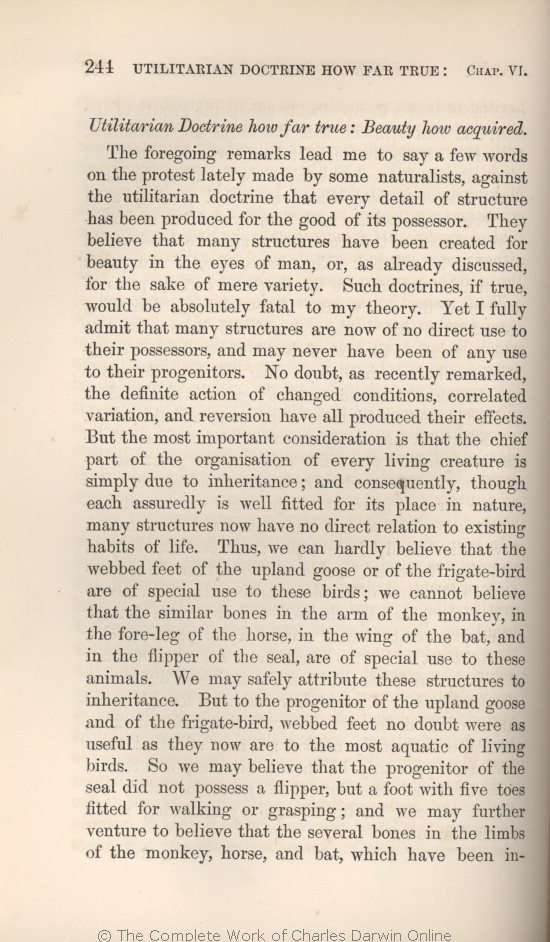The foregoing remarks lead me to say a few words on the protest lately made by some naturalists, against the utilitarian doctrine that every detail of structure has been produced for the good of its possessor. They believe that
..| ..... 1869 1872 | | very 1859 1860 1861 1866 |
| beauty in the eyes of 1859 1860 1861 1866 1869 |
| the sake of beauty, to delight 1872 |
| man, 1859 1860 1861 1866 1869 | | man 1872 |
| or, as already discussed, for the sake of 1869 |
| or for 1859 1860 1861 |
| or, as already mentioned and discussed, for the sake of 1866 |
| or the Creator (but this latter point is beyond the scope of scientific discussion), or for the sake of 1872 |
| variety. 1859 1860 1861 1866 1869 |
| variety, a view already discussed. 1872 |
| Such 1866 1869 1872 | | This 1859 1860 1861 |
| doctrines, 1866 1869 1872 | | doctrine, 1859 1860 1861 |
| Yet 1859 1860 1861 1866 1869 | Yet 1872 |
| now of 1869 1872 | | of 1859 1860 1861 1866 |
| possessors, and may never have been of any use to their progenitors. 1869 |
| possessors. 1859 1860 1861 1866 |
| possessors, and may never have been of any use to their progenitors; but this does not prove that they were formed solely for beauty or variety. 1872 |
| as recently remarked, 1869 |
| OMIT 1872 |
| correlated variation, and reversion 1869 |
| and the various causes of modifications, lately specified, 1872 |
| effects. 1869 |
| effect, probably a great effect, independently of any advantage thus gained. 1872 |
| the most 1869 |
| a still more 1872 |
| assuredly 1869 | | being assuredly 1872 |
| now have 1869 | | have now 1872 |
| direct 1869 |
| very close and direct 1872 |
| existing 1869 | | present 1872 |
| 3 blocks not present in 1869 1872; present in 1859 1860 1861 1866 | | Physical conditions probably have had some little effect
on structure, quite independently of any good thus gained.
Correlation of growth has
no doubt played a most important part,
and a useful modification of one part will
often have
entailed on other parts diversified
changes of no
direct use.
So again characters which formerly were useful, or which formerly had arisen from correlation of growth, or from other unknown cause,
may reappear from the law of reversion, though now of no direct use.
|
| 1 blocks not present in 1866 1869 1872; present in 1859 1860 1861 | | The effects of sexual selection, when displayed in beauty to charm the females, can be called useful only in rather a forced sense.
|
| similar 1861 1866 1869 1872 | | same 1859 1860 |
| fore-leg 1860 1861 1866 1869 1872 |
| fore leg of 1859 |
| of the 1860 1861 1866 1869 1872 | | the 1859 |
| to 1859 1860 1861 1866 1869 |
| webbed feet no doubt were as useful to 1872 |
| webbed feet no doubt were as useful 1859 1860 1861 1866 1869 |
| OMIT 1872 |
| living 1869 1872 | | existing 1859 1860 1861 1866 |
| did 1869 1872 | | had 1859 1860 1861 1866 |
| possess a 1869 1872 | | a 1859 1860 1861 1866 |
| which have been in- herited from some ancient progenitor, were formerly 1869 |
| which have been inherited from a common progenitor, were formerly 1859 1860 1861 1866 |
| were originally developed, on the principle of utility, probably through the reduction 1872 |
|









